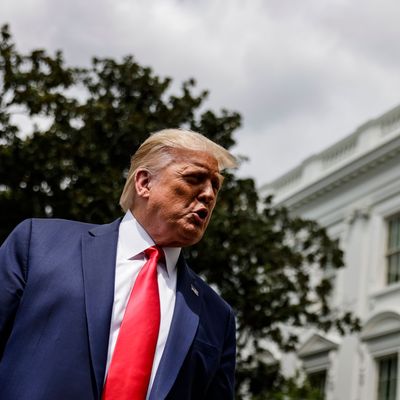
Heading into a weekend during which Congress was originally supposed to head off on a long August recess, coronavirus stimulus talks between the White House and congressional Democrats have all but ground to a halt, as Trump mulls executive actions sure to be challenged in court and a glass-half-full, glass-half-empty jobs report for July arrives that will probably drive the two parties further apart. It’s a big, fat mess all around, with next steps entirely unclear.
On the negotiating front, Politico reports that both sides seem inclined to focus on blaming the breakdown in talks on each other:
TEN MEETINGS between Speaker NANCY PELOSI, Senate Minority Leader CHUCK SCHUMER, White House chief of staff MARK MEADOWS and Treasury Secretary STEVEN MNUCHIN over two weeks have yielded little more than bickering and resentment.
AT JUST BEFORE 8:30 THURSDAY NIGHT, after a three-hour meeting, negotiators emerged to say they had made progress on small-bore items, but remain trillions of dollars apart on an overall package, and still had no agreement on the big items like enhanced unemployment insurance and state and local funding.
FOR NOW, there won’t be another Covid stimulus bill, and now both sides will have to figure out how to position themselves amid the rubble of what might be Congress’ biggest swing and miss in a decade.
The potential deal that areas of agreement pointed toward would have deeply disappointed Democrats by likely eliminating further stimulus until after the elections, while perhaps encouraging a congressional Republican revolt that would have imperiled passage of the deal in the Senate:
THERE WAS A REALLY, REALLY EASY package here that was a bit too much for Republicans, and far too little for Democrats, but would’ve easily passed: PPP renewal, direct payments [of a second round of $1200 stimulus checks], extension of enhanced unemployment, $105 billion in education funding, eviction moratorium, testing money, $200 billion in state and local, $10 billion for USPS and SNAP money.
The July jobs report probably gives Senate conservatives what they were looking for by way of evidence that the economy is recovering slowly but surely without further stimulus, while giving Democrats and perhaps some vulnerable Republican candidates grounds for arguing that the recovery is stalling and will soon plunge the economy back into a free fall.
But as everyone in Washington assesses the rapidly evolving situation, complicated by perilous school reopenings around the country, Donald Trump could change the equation overnight with executive actions focused on implementing his pet idea of a federal payroll tax cut while addressing expiring CARES Act provisions. According to most reports, Trump’s orders would extend federal unemployment-insurance supplements, a moratorium on evictions in federally assisted rental housing, and another moratorium on student loan payments. Aside from questions about his legal authority to do any of this, Trump’s tentative plans would fund the most expensive part of this plan, the UI benefits, by recouping CARES Act funds from state and local governments at the very time they are begging for many hundreds of billions more in federal assistance, as Caitlin Emma explains:
The CARES Act passed by Congress in March included a total of $150 billion for state and local governments. The Treasury Department recently released data showing that, as of June 30, only a quarter of that money has been spent.
The Trump administration believes it can tap as much as $81 billion of that unspent money to offer states the ability to take advantage of beefed up unemployment benefits …
But while much of the aid hasn’t been spent, most of the money is already spoken for.
A recent survey by the National Association of Budget Officers found three quarters of the $150 billion has been committed for specific purposes, like health care providers, business relief, distance learning for students, housing assistance and more. And states can technically already use the money for unemployment insurance costs, according to Treasury Department guidance.
States have had to budget carefully while dealing with a tremendous amount of uncertainty amid the coronavirus pandemic. They’re also barred from using any of the funds to plug up enormous budget gaps — a flexibility that many Democrats and Republicans now realize states need. In some cases, states have hesitated to allocate additional cash, with the hopes that such flexibility will materialize.
Indeed, this “flexibility” was on offer in the White House/Senate GOP proposal as a meager alternative to the near-trillion dollars Democrats were proposing for new assistance to state and local governments.
So if an executive order cannibalizes this money to extend UI benefits, both Republican and Democratic state and local leaders are probably going to freak out and head to court, which could rain on any Trump parade designed to show a benevolent president rushing to the aid of suffering multitudes while The Swamp is mired in gridlock.
The next few days could determine where the two parties wind up positioning themselves on stimulus measures heading into the end of the fiscal year and then the pre-election stretch, even as many millions of Americans wonder about that second stimulus check everyone supposedly agrees should go out.






























